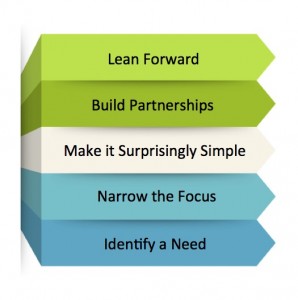5-Steps to Persistent Success
Business leaders visualize how they can lead their companies to new heights. Entrepreneurs dream of building widely successful businesses. Inventors imagine solving the world’s greatest problems.
A few manage to do it in spite of the odds and create competitive advantage.
Some examples:
- 3M’s Post-It Notes – simple concept, reflected in the name.
- Google search – delivers quick, relevant answers in a simple, clean layout.
- Apple iPod and subsequent iPhone – simple, clean, intuitive design.
- Amazon 1-Click Ordering – pioneered the easiest and simplest way to order products online.
- Tesla S – many fewer parts than traditional vehicles, with a clean, sleek design.
- TOMS shoes – making it simple and easy to help children in need when buying a shoes.
How do the leaders of these companies manage to outperform competitors and stay ahead of start-ups?
While there is no magic formula, I believe each found their unique sweet spot by following 5-steps to persistent success.
5-Steps to Persistent Success
 Entrepreneurs, business leaders, and inventors that achieve persistent success tend to follow the following 5-Steps:
Entrepreneurs, business leaders, and inventors that achieve persistent success tend to follow the following 5-Steps:
- Identify a Need. This is the crucial first step of insight gathering. Observing human nature, studying what’s working and what’s not working well; and constantly looking for opportunities to improve people’s lives, either directly or indirectly. This applies across B2C, B2B, and even B2G as buyers are human.
- Narrow the Focus. This is about cutting through the clutter and noise, stripping away the irrelevant, and answering the most important question: What’s the one thing that matters most?
- Make It Surprisingly Simple (MISS). The concept of simplicity is deceiving. Making a product or service simple is difficult. It’s too easy to keep adding features (because more must be better, right?), thinking customers will want them and intuitively understand how to use them. The best products and services keep the necessary in and the unnecessary out.
- Build Partnerships. More than ever, we live in an interconnected world. Persistent success is built by helping others be successful too. This might mean two (or more) companies collaborating on one front while competing on another (it’s called co-opetition). It’s all part of the new world of business.
- Lean Forward. While some call it agile, the idea behind lean thinking is to create more value for customers with fewer resources. But it’s not just about companies being more efficient. It’s about moving forward with customers, learning and adapting quickly to meet customer needs, and thereby staying ahead of competitors and remaining the preferred choice.
One Thing That Matters Most
So what’s the one thing that matters most here?
Simplicity
The most difficult part for any company is to do the hard work of keeping products and services simple. It requires everyone to constantly battle the complicated, remove complexity, and keep the elementary front and center.
The reality is that differences of opinion, personal interests, competing agendas, internal politics, and lack of strong leadership all contribute to scope-creep, fuzzy branding, and less-than-ideal product quality. This happens in 3-person shops to major conglomerates.
The solution?
Clarify with differentiating values, and as I explain in a previous article, maximum 3 values. This ensures everyone is operating from the same playbook, and remains focused on the few things that truly matter.
What else can leaders do to incorporate simplicity into their company culture?









